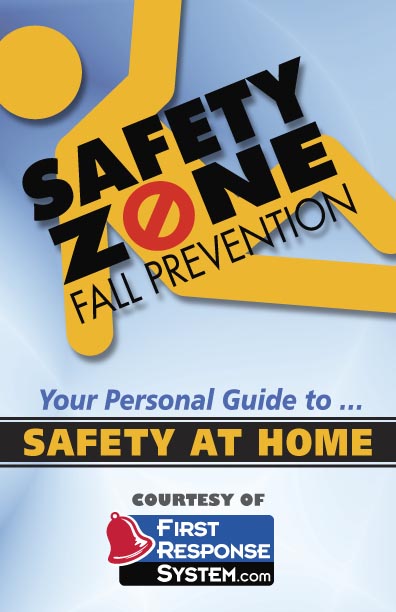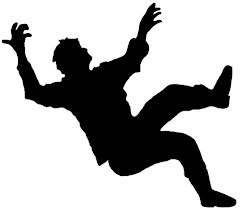Falls are the leading cause of injury among older adults. The good news is older adults can reduce the risk of falling or repeated falls (called recurring falls) by educating themselves and their family member caregivers on fall prevention safety. First Response System has created a comprehensive fall prevention education program called “Creating Your Own Fall Prevention Safety Zone”. Beside the educational components of our program, we have also created a brochure and booklet set that provides easy-to-use checklists for a variety of fall prevention strategies that can reduce the risk of falling by up to 75% over time.
 Step 1: Are You A High Risk Candidate to Fall? – Take Our Fall Risk Self-Test
Step 1: Are You A High Risk Candidate to Fall? – Take Our Fall Risk Self-Test
Complete our quick 12-point questionnaire and compile your score to determine your particular level of fall-risk. You can complete the questionnaire by yourself or with the assistance of a family member, neighbor, physician or local health care provider. If you score as a likely candidate to fall or have a recurring fall, please review this self-test with a health care professional to determine the proper course of action. The questionnaire discusses physical, medical, emotional and medicinal topics with yes/no responses to each item to derive a score.
Step 2: Schedule An Annual Wellness Appointment
Schedule an Annual Wellness Appointment (your birth date might be easy to remember) with your primary physician or local healthcare provider to review, discuss, modify and treat any existing and/or emerging medical conditions to reduce your risk of falling while improving your overall health and well-being. First Response has created a simple checklist that you can review with your physician that focuses on:
- Medical history; medical records
- Chronic ailments
- Medications
- Physical exam
- Gait, strength, response and balance tests
- Fall risk screening
- Vitamin D supplement
- Vision
- Exercise
- Footwear and clothing
- Referrals to specialists
- Update medical assist devices
Step 3: Conduct Your Own Home Safety Walk-Through
First Response has conceived a Home Safety Walk-Through booklet to identify home hazards that are specific to each room of the house. A room-by-room checklist can be used to make the process more manageable and effective. Each checklist focuses on a particular environment of the house- the living room, dining room, kitchen, bedroom, bathroom, stairwells and hallways.
Step 4: Modify Your Home Hazards
Once you have identified specific home hazards in your household, use our other room-by-room checklists to remove, modify or replace the hazards to dramatically reduce the potential risk of falling. Many of these modifications are easy to accomplish, accessible, affordable, if any cost to you at all.
Step 5: Personal Emergency Medical Data Form
In the event of a medical emergency in your home, local 911 responders may look for additional guidance to treat you more effectively at the scene. Placing an emergency medical data form (known as a “vial of life” for many years) on your refrigerator door is where emergency responders look to first for medical treatment assistance. First Response provides our clients and all older adults (particularly those at risk) with a durable clear baggie and heavy-duty magnetic clip that securely stores your medical form for easy access by local responders.
Step 6: Medical Alert Protection At Home 24/7
Now that you haven taken important steps to prevent or reduce falls and related accidents and injuries from happening, it is important to consider 24/7 medical alert system protection in the event an accident does occur- especially when you’re alone. Most of our medical alert system clients report they use our services because they have fallen. Studies indicate that 50% of falls occur due to the daily anxiety an older adult experiences in anticipation of a fall. Our First Response emergency medical alert system offers peace of mind and a total feeling of security and protection 24/7.
Step 7: Assistive Medical Devices and Products
Canes, walkers, night lights, lumbar cushions and other safety products offer older adults and their families a way to stay independent, keep active, reduce stress and enjoy life. Our safety and lifestyle product categories include bathroom safety, mobility, lighting, daily life aids, accessory items, medical alert systems and devices.
Report Falls And Related Accidents & Injuries To Others
Older adults often feel reporting a fall or related accident or injury to others can be detrimental to their current lifestyle. Fear of losing one’s independence, home, mobility, even friends- can make older adults turn inward and isolate themselves from sharing their life with others. By changing this behavior, reporting falls and medical conditions to family, friends and medical professionals actually INCREASES the likelihood an older adult maintaining their independent lifestyle and longevity of life.
Helpful Tip: Review Your Plan Every 6 Months
Review your First Response Safety Plan every 3 to 6 months; particularly medications as they tend to change more rapidly. Stay in touch with your primary physician, pharmacist and family member caregivers on a regular basis- make them an active part of your independent lifestyle “team”.










 “I am very uneasy and have had many falls after my surgery. Ordering the First Response system was easy and I even set it up myself. I have had to use my alert button a few times so far. My daughter has even been contacted after I had taken a few falls. My First Response system has worked great each time I’ve needed it!”
“I am very uneasy and have had many falls after my surgery. Ordering the First Response system was easy and I even set it up myself. I have had to use my alert button a few times so far. My daughter has even been contacted after I had taken a few falls. My First Response system has worked great each time I’ve needed it!”